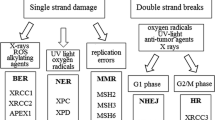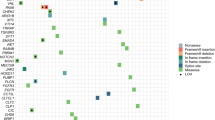Abstract
Glutathione peroxidase is a selenium-containing, antioxidant enzyme previously implicated in the risk and development of lung and breast cancer, in part the result of allelic loss at the GPx-1 locus. This study examined allelic loss at the same locus in squamous cell carcinomas of the head and neck. The frequency of a polymorphism at codon 198 resulting in either a leucine or a proline at that position was surveyed by comparing 133 DNA samples obtained from head and neck tumors and 517 samples obtained from cancer-free individuals. Tumor DNAs exhibited fewer pro/leu heterozygotes as compared to DNA obtained from the cancer-free population. Fewer GPx-1 heterozygotes were verified by determining the frequency of highly polymorphic alanine repeat sequences in the same gene. The analysis revealed an approximately 42% reduction in heterozygosity in the DNA from the tumor samples. In order to assess loss of heterozygosity (LOH) at the GPx-1 locus, DNA was genotyped from peripheral lymphocytes, tumor tissue, and microscopically normal tissues adjacent to the tumor, derived from the same patients. These studies indicated LOH at the GPx-1 locus in each of the three tumor/normal tissues sample sets examined. Furthermore, LOH in the microscopically normal tissues at the tumor margin occurred in two of the three sample sets examined. These data implicate GPx-1 in the development of squamous cell carcinoma the head and neck and suggest that allelic loss of this gene, or one tightly linked to it, is an early event in the development of this type of malignancy.
Similar content being viewed by others
References
M. P. Tabor, R. H. Brakenhoff, V. M. van Houten, et al., Persistence of genetically altered fields in head and neck cancer patients: biological and clinical implications, Clin. Cancer Res. 7, 1523–1532 (2001).
B. J. Braakhuis, M. P. Tabor, J. A. Kummer, C. R. Leemans, and R. H. Brakenhoff, A genetic explanation of Slaughter’s concept of field cancerization: evidence and clinical implications, Cancer Res. 63, 1727–1730 (2003).
S. B. Garcia, H. S. Park, M. Novelli, and N. A. Wright, Field cancerization, clonality, and epithelial stem cells: the spread of mutated clones in epithelial sheets, J. Pathol. 137, 61–81 (1999).
J. Califano, P. van der Riet, W. Westra, et al., Genetic progression model for head and neck cancer: implications for field cancerization, Cancer Res. 56, 2488–2492 (1996).
J. A. Moscow, L. Schmidt, D. T. Ingram, J. Gnarra, B. Johnson, and K. H. Cowan, Loss of heterozygosity of the human cytosolic glutathione peroxidase I gene in lung cancer, Carcinogenesis 15, 2769–2773 (1994).
Y. J. Hu and A. M. Diamond, Role of glutathione peroxidase 1 in breast cancer: loss of heterozygosity and allelic differences in the response to selenium, Cancer Res. 63, 3347–3351 (2003).
D. Ratnasinghe, J. A. Tangrea, M. R. Andersen, et al., Glutathione peroxidase codon 198 polymorphism variant increases lung cancer risk, Cancer Res. 60, 6381–6383 (2000).
K. El-Bayoumy, The Role of Selenium in Cancer Prevention, Lippincott, Philadelphia, pp. 1–15 (1991).
W. J. Goodwin, Jr., G. D. Bordash, F. Huijing, and N. Altman, Inhibition of hamster tongue carcinogenesis by selenium and retinoic acid, Ann. Otol. Rhinol. Laryngol. 95, 162–166 (1986).
I. Inoue, Y. Yamamoto, T. Takasaki, and H. Takahashi, Inhibitory effects of selenium, vitamin A and butylated hydroxytoluene on in vitro growth of human tongue cancer cells, Eur. Arch. Otorhinolaryngol. 252, 509–512 (1995).
A. Ghose, J. Fleming, K. El-Bayoumy, and P. R. Harrison, Enhanced sensitivity of human oral carcinomas to induction of apoptosis by selenium compounds: involvement of mitogen-activated protein kinase and Fas pathways, Cancer Res. 61, 7479–7487 (2001).
L. Kiremidjian-Schumacher, M. Roy, R. Lickman, et al., Selenium and immunocompetence in patients with head and neck cancer, Biol. Trace Element Res. 73, 97–111 (2000).
Y. J. Hu, K. V. Korotkov, R. Mehta, et al., Distribution and functional consequences of nucleotide polymorphisms in the 3′-untranslated region of the human Sep 15 gene, Cancer Res. 61, 2307–2310 (2001).
L. C. Clark, G. F. J. Combs, B. W. Turnbull, et al., Effects of selenium supplementation for cancer prevention in patients with carcinoma of the skin. A randomized controlled trial, J. Am. Med. Assoc. 276, 1957–1963 (1996).
S. Y. Yu, Y. J. Zhu, and W. G. Li, Protective role of selenium against hepatitis B virus and primary liver cancer in Qidong, Biol. Trace Element Res. 56, 117–124 (1997).
Author information
Authors and Affiliations
Additional information
Author to whom all correspondence and reprint requests should be addressed. These authors contributed equally to this work.
Rights and permissions
About this article
Cite this article
Hu, Y.J., Dolan, M.E., Bae, R. et al. Allelic loss at the GPx-1 locus in cancer of the head and neck. Biol Trace Elem Res 101, 97–106 (2004). https://doi.org/10.1385/BTER:101:2:097
Received:
Accepted:
Issue Date:
DOI: https://doi.org/10.1385/BTER:101:2:097




